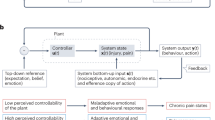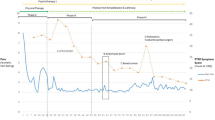Abstract
This paper presents a model of chronic pain [Young and Chapman (Pain, affect, nonlinear dynamical systems, and chronic pain: Bringing order to disorder. In G. Young, A. W. Kane, & K. Nicholson (Eds.), Causality of psychological injury: Presenting evidence in court (pp. 197–241). New York: Springer, 2007)]. It includes extensive coverage of the systems perspective. The paper expands the model to medically unexplained symptoms and provides a developmental model of how these may unfold and influence adult presentation after events such as accidents. Similarly, the model is examined for the developmental roots of personality disorder. The paper examines other threats to validity of diagnosis in cases of psychological injury.
Similar content being viewed by others
References
American Psychiatric Association (1994). Diagnostic and statistical manual of mental disorders (4th ed.). Washington, DC: Author.
American Psychiatric Association (2000). Diagnostic and statistical manual of mental disorders (4th ed.). Washington, DC: Author.
Asmundson, G. J. G., & Taylor, S. (2006). PTSD and chronic pain: Cognitive-behavioral perspectives and practical implications. In G. Young, A. W. Kane, & K. Nicholson (Eds.), Psychological knowledge in court: PTSD, pain, and TBI (pp. 225–241). New York: Springer.
Asmundson, G. J. G., & Wright, K. D. (2004). Biopsychosocial approaches to pain. In T. Hadjistavropoulos & K. D. Craig (Eds.), Pain: Psychological perspectives (pp. 35–57). Mahwah, NJ: Erlbaum.
Chapman, M. (1998). Constructive evolution: Origins and development of Piaget’s thought. New York: Cambridge University Press.
Costa Jr., P. T., & McCrae, R. R. (1990). Personality disorders and the five-factor model of personality. Journal of Personality Disorders, 4, 362–371.
Costa, P. T., Jr., & Widiger, T. A. (Eds.) (2002a). Personality disorders and the five-factor model of personality, 2nd edn. Washington, DC: American Psychological Association.
Costa Jr., P. T., & Widiger, T. A. (2002b). Introduction: Personality disorder and the five-factor model of personality. In P. T. Costa Jr, & T. A. Widiger (Eds.), Personality disorders and the five-factor model of personality (pp. 3–14, 2nd ed.). Washington, DC: American Psychological Association.
Deary, V., Chalder, T., & Sharpe, M. (2007). The cognitive behavioural model of medically unexplained symptoms: a theoretical and empirical review. Clinical Psychology Review, 27, 781–797.
Depue, R. A., & Lenzenweger, M. F. (2005). A neurobiological dimensional model of personality disturbance. In M. F. Lenzenweger, & J. F. Clarkin (Eds.), Major theories of personality disorder (pp. 391–453, 2nd ed.). New York: Guilford.
DiClemente, C. C., & Prochaska, J. O. (1982). Self-change and therapy change of smoking behavior: A comparison of processes of change in cessation and maintenance. Addictive Behaviors, 7, 133–142.
Francis, S. E. (1995). Chaotic phenomena in psychophysiological self-regulation. In R. Robertson, & A. Combs (Eds.), Chaos theory in psychology and the life sciences (pp. 253–265). Mahwah, NJ: Erlbaum.
Gatchel, R. J. (2005). Clinical essentials of pain management. Washington, DC: American Psychological Association.
Gatchel, R., & Kishino, N. (2006). The influence of personality characteristics on pain patients: Implications for causality in pain. In G. Young, A. W. Kane, & K. Nicholson (Eds.), Psychological knowledge in court: PTSD, pain, and TBI (pp. 149–162). New York: Springer.
Gleick, J. (1987). Chaos. New York: Viking Penguin.
Gottman, J. M. (1991). Chaos and regulated change in families: A metaphor for the study of transitions. In P. A. Cowen, & M. Hetherington (Eds.), Family transitions (pp. 247–272). Hillsdale, NJ: Erlbaum.
Granic, I., & Patterson, G. R. (2006). Toward a comprehensive model of antisocial development: A dynamic systems approach. Psychological Review, 113, 101–131.
Johnson, S. K. (2008). Medically unexplained illness: Gender and biopsychosocial implications. Washington, DC: American Psychological Association.
Kauffman, S. A. (1993). The origins of order. New York: Oxford University Press.
Koch, W. J., Douglas, K. S., Nicholls, T. L., & O’Neill, M. L. (2006). Psychological injuries: Forensic assessment, treatment, and law. Oxford: Oxford University Press.
Lansing, J. S. (2003). Complex adaptive systems. Annual Review of Anthropology, 32, 183–204.
Lenzenweger, M. F., & Clarkin, J. F. (Eds.) (2005). Major theories of personality disorder, 2nd edn. New York: Guilford.
Livneh, H., & Parker, R. M. (2005). Psychological adaptation to disability: perspectives from chaos and complexity theory. Rehabilitation Counseling Bulletin, 49(1), 17–28.
Maddox, J. E. (1995). Yes, people can change, but can psychotherapists? Contemporary Psychology, 40, 1047–1048.
Melzack, R. (1999). Pain and stress: A new perspective. In R. J. Gatchel, & D. C. Turk (Eds.), Psychosocial factors in pain: Critical perspectives (pp. 89–106). New York: Guilford.
Melzack, R., & Katz, J. (2006). Pain in the 21st century: The neuromatrix and beyond. In G. Young, A. W. Kane, & K. Nicholson (Eds.), Psychological knowledge in court: PTSD, pain, and TBI (pp. 129–148). New York: Springer.
Melzack, R., & Wall, P. D. (1965). Pain mechanisms: a new theory. Science, 150, 971–979.
Otis, J. D., Pincus, D., & Keane, T. M. (2006). Comorbid chronic pain and Posttraumatic Stress Disorder across the lifespan: A review of theoretical models. In G. Young, A. W. Kane, & K. Nicholson (Eds.), Psychological knowledge in court: PTSD, pain, and TBI (pp. 242–268). New York: Springer.
Pincus, T. (2006). The effect of cognition on pain experience and pain behavior: Diatheses-stress and the causal conundrum. In G. Young, A. W. Kane, & K. Nicholson (Eds.), Psychological knowledge in court: PTSD, pain, and TBI (pp. 163–180). New York: Springer.
Prochaska, J. O., DiClemente, C. C., & Norcross, J. C. (1992). In search of how people change: Applications to addictive behaviors. American Psychologist, 47, 1102–1114.
Prochaska, J. O., Norcross, J. C., & DiClemente, C. C. (1994). Changing for good: The revolutionary program that explains the six stages of change and teaches you how to free yourself from bad habits. New York: Morrow.
Rief, W., & Broadbent, E. (2007). Explaining medically unexplained symptoms–models and mechanisms. Clinical Psychology Review, 27, 821–841.
Schultz, I. Z., & Stewart, A. (2008). Disentangling the disability quagmire in psychological injury and law. Part 2. Evolution of disability models: Conceptual, methodological and forensic practice issues. Psychological Injury and Law, 1(2), 94–102.
Selye, H. (1951). The general adaptation syndrome and the gastrointestinal diseases of adaptation. American Journal of Proctology, 2, 167–184 303, 1157–1162.
Taylor, S. (2006). Clinician’s guide to PTSD: A cognitive-behavioral approach. New York: Guilford.
Turk, D. C. (2003). Chronic pain and whiplash associated disorders: rehabilitation and secondary prevention. Pain Research & Management, 8, 40–43.
Young, G. (1997). Adult development, therapy, and culture: A postmodern synthesis. New York: Plenum.
Young, G. (2007). Causality: Concepts, issues, and recommendations. In G. Young, A. W. Kane, & K. Nicholson (Eds.), Causality of psychological injury: Presenting evidence in court (pp. 49–86). New York: Springer.
Young, G. (2008a). Psychological injury and law: an integrative model. Psychological Injury and Law, 1(3), 150–160.
Young, G. (2008b). Causality and causation in law, medicine, psychiatry, and psychology: Progression or regression? Psychological Injury and Law, 1(3), 161–181.
Young, G. (2008c). Personality disorder in psychological injury: a biopsychosocial and forensic perspective. Psychological Injury and Law, 4.
Young, G., & Chapman, C. R. (2006). Chronic pain and affect as a nonlinear dynamical system. In G. Young, A. W. Kane, & K. Nicholson (Eds.), Psychological knowledge in court: PTSD, pain, and TBI (pp. 181–192). New York: Springer.
Young, G., & Yehuda, R. (2006). Understanding PTSD: Implications for court. In G. Young, A. W. Kane, & K. Nicholson (Eds.), Psychological knowledge in court: PTSD, pain, and TBI (pp. 55–69). New York: Springer.
Young, G., & Chapman, C. R. (2007). Pain, affect, nonlinear dynamical systems, and chronic pain: Bringing order to disorder. In G. Young, A. W. Kane, & K. Nicholson (Eds.),Causality of psychological injury: Presenting evidence in court (pp. 197–241). New York: Springer.
Acknowledgements
Many thanks to a reviewer for helpful comments on the text.
The author’s work has been supported by course leaves granted by both Glendon College and York University and editorial grants from Springer Science + Business Media.
Conflicts of interest
In terms of possible conflicts of interest, the author has obtained most of his attorney referrals and psycholegal referrals from plaintiff rather than defense attorneys and assessment companies.
Author information
Authors and Affiliations
Corresponding author
Rights and permissions
About this article
Cite this article
Young, G. Psychological Injury: Systems, Change Processes, Development. Psychol. Inj. and Law 1, 243–254 (2008). https://doi.org/10.1007/s12207-008-9020-5
Received:
Accepted:
Published:
Issue Date:
DOI: https://doi.org/10.1007/s12207-008-9020-5




